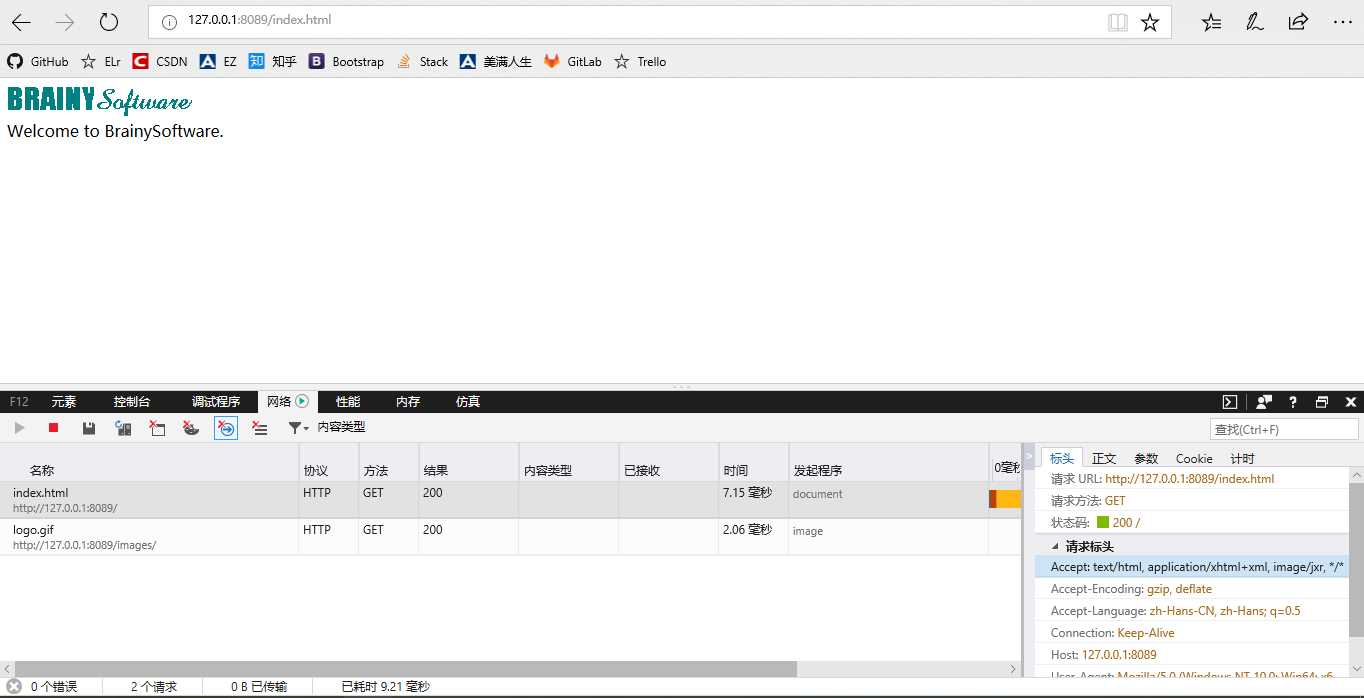标签:构造函数 resource text 3.3 exist iat 端口 远程 set
基于JavaWeb服务器会使用到两个重要的类:java.net.Socket类和java.net.ServerSocket类,并通过发送HTTP消息进行通信。
public Socket(java.net.String host,int port)//如果主机只有一个IP 地址, 那么默认情况下, 服务器程序就与该IP 地址绑定. ServerSocket 的第 4 个构造方法 ServerSocket(int port, int backlog, InetAddress bingAddr) 有一个 bindAddr 参数, 它显式指定服务器要绑定的IP 地址, 该构造方法适用于具有多个IP 地址的主机. 假定一个主机有两个网卡, 一个网卡用于连接到 Internet, IP为 222.67.5.94, 还有一个网卡用于连接到本地局域网, IP 地址为 192.168.3.4. 如果服务器仅仅被本地局域网中的客户访问, 那么可以按如下方式创建 ServerSocket:
ServerSocket serverSocket = new ServerSocket(8000, 10, InetAddress.getByName("192.168.3.4"));```java
package ex01.pyrmont;
import java.net.Socket;
import java.net.ServerSocket;
import java.net.InetAddress;
import java.io.InputStream;
import java.io.OutputStream;
import java.io.IOException;
import java.io.File;
public class HttpServer {
/** WEB_ROOT is the directory where our HTML and other files reside.
* For this package, WEB_ROOT is the "webroot" directory under the working
* directory.
* The working directory is the location in the file system
* from where the java command was invoked.
*/
public static final String WEB_ROOT =
System.getProperty("user.dir") + File.separator + "webroot";
// shutdown command
private static final String SHUTDOWN_COMMAND = "/SHUTDOWN";
// the shutdown command received
private boolean shutdown = false;
public static void main(String[] args) {
HttpServer server = new HttpServer();
server.await();
}
public void await() {
ServerSocket serverSocket = null;
int port = 8080;
try {
serverSocket = new ServerSocket(port, 1, InetAddress.getByName("127.0.0.1"));
}
catch (IOException e) {
e.printStackTrace();
System.exit(1);
}
// Loop waiting for a request
while (!shutdown) {
Socket socket = null;
InputStream input = null;
OutputStream output = null;
try {
socket = serverSocket.accept();
input = socket.getInputStream();
output = socket.getOutputStream();
// create Request object and parse
Request request = new Request(input);
request.parse();
// create Response object
Response response = new Response(output);
response.setRequest(request);
response.sendStaticResource();
// Close the socket
socket.close();
//check if the previous URI is a shutdown command
shutdown = request.getUri().equals(SHUTDOWN_COMMAND);
}
catch (Exception e) {
e.printStackTrace();
continue;
}
}
}```java
package ex01.pyrmont;
import java.io.InputStream;
import java.io.IOException;
public class Request {
private InputStream input;
private String uri;
public Request(InputStream input) {
this.input = input;
}
public void parse() {//解析HTTP请求中原始数据
// Read a set of characters from the socket
StringBuffer request = new StringBuffer(2048);
int i;
byte[] buffer = new byte[2048];
try {
i = input.read(buffer);
}
catch (IOException e) {
e.printStackTrace();
i = -1;
}
for (int j=0; j<i; j++) {
request.append((char) buffer[j]);
}
System.out.print(request.toString());
uri = parseUri(request.toString());
}
private String parseUri(String requestString) {
int index1, index2;
index1 = requestString.indexOf(‘ ‘);
if (index1 != -1) {
index2 = requestString.indexOf(‘ ‘, index1 + 1);
if (index2 > index1)
return requestString.substring(index1 + 1, index2);
}
return null;
}
public String getUri() {
return uri;
}}
package ex01.pyrmont;
import java.io.OutputStream;
import java.io.IOException;
import java.io.FileInputStream;
import java.io.File;
/*
HTTP Response = Status-Line
*(( general-header | response-header | entity-header ) CRLF)
CRLF
[ message-body ]
Status-Line = HTTP-Version SP Status-Code SP Reason-Phrase CRLF
*/
public class Response {
private static final int BUFFER_SIZE = 1024;
Request request;
OutputStream output;
public Response(OutputStream output) {
this.output = output;
}
public void setRequest(Request request) {
this.request = request;
}
public void sendStaticResource() throws IOException {
byte[] bytes = new byte[BUFFER_SIZE];
FileInputStream fis = null;
try {
File file = new File(HttpServer.WEB_ROOT, request.getUri());
if (file.exists()) {
fis = new FileInputStream(file);
int ch = fis.read(bytes, 0, BUFFER_SIZE);
while (ch!=-1) {
output.write(bytes, 0, ch);
ch = fis.read(bytes, 0, BUFFER_SIZE);
}
}
else {
// file not found
String errorMessage = "HTTP/1.1 404 File Not Found\r\n" +
"Content-Type: text/html\r\n" +
"Content-Length: 23\r\n" +
"\r\n" +
"<h1>File Not Found</h1>";
output.write(errorMessage.getBytes());
}
}
catch (Exception e) {
// thrown if cannot instantiate a File object
System.out.println(e.toString() );
}
finally {
if (fis!=null)
fis.close();
}
}
}运行结果

标签:构造函数 resource text 3.3 exist iat 端口 远程 set
原文地址:https://www.cnblogs.com/Black-Cobra/p/8901051.html